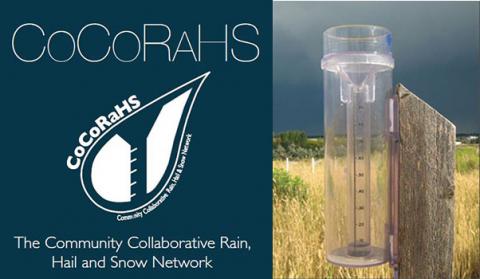Citizen Science Opportunity With CoCoRaHS
go.ncsu.edu/readext?996099
en Español / em Português
El inglés es el idioma de control de esta página. En la medida en que haya algún conflicto entre la traducción al inglés y la traducción, el inglés prevalece.
Al hacer clic en el enlace de traducción se activa un servicio de traducción gratuito para convertir la página al español. Al igual que con cualquier traducción por Internet, la conversión no es sensible al contexto y puede que no traduzca el texto en su significado original. NC State Extension no garantiza la exactitud del texto traducido. Por favor, tenga en cuenta que algunas aplicaciones y/o servicios pueden no funcionar como se espera cuando se traducen.
Português
Inglês é o idioma de controle desta página. Na medida que haja algum conflito entre o texto original em Inglês e a tradução, o Inglês prevalece.
Ao clicar no link de tradução, um serviço gratuito de tradução será ativado para converter a página para o Português. Como em qualquer tradução pela internet, a conversão não é sensivel ao contexto e pode não ocorrer a tradução para o significado orginal. O serviço de Extensão da Carolina do Norte (NC State Extension) não garante a exatidão do texto traduzido. Por favor, observe que algumas funções ou serviços podem não funcionar como esperado após a tradução.
English
English is the controlling language of this page. To the extent there is any conflict between the English text and the translation, English controls.
Clicking on the translation link activates a free translation service to convert the page to Spanish. As with any Internet translation, the conversion is not context-sensitive and may not translate the text to its original meaning. NC State Extension does not guarantee the accuracy of the translated text. Please note that some applications and/or services may not function as expected when translated.
Collapse ▲
Citizen Science Program Needs Your Help Observing the Weather!
Have you ever wondered how much rain fell during a recent thunderstorm? How about snowfall during a winter storm? If so, an important volunteer weather observing program needs your help!
What is Citizen Science?
Citizen Science is scientific research that is conducted by members of the general public! A group of people work together to collect and analyze scientific data for a common cause. Citizen science helps collect important data which can be used to make important scientific discoveries!
The Community Collaborative Rain, Hail, and Snow network, or CoCoRaHS, is looking for new volunteers across North Carolina. The grassroots effort is part of a growing national network of home-based and amateur weather spotters with a goal of providing a high density precipitation network across the country.
CoCoRaHS came about as a result of a devastating flash flood that hit Fort Collins, Colorado, in July 1997. A local severe thunderstorm dumped over a foot of rain in several hours while other portions of the city had only modest rainfall. The ensuing flood caught many by surprise and caused $200 million in damages. CoCoRaHS was born in 1998 with the intent of doing a better job of mapping and reporting intense storms. As more volunteers participated, rain, hail, and snow maps were produced for every storm showing fascinating local patterns that were of great interest to scientists and the public. Recently, drought reporting has also become an important observation within the CoCoRaHS program across the nation. In fact, drought observations from CoCoRaHS are now being included in the National Integrated Drought Information System.
North Carolina became the twenty-first state to join the CoCoRaHS program in 2007, and by 2010, the CoCoRaHS network had reached all 50 states with nearly 10,000 daily observations. Through CoCoRaHS, thousands of volunteers, young and old, document the size, intensity, duration and patterns of rain, hail, and snow by taking simple measurements in their own backyards.
Volunteers may obtain an official rain gauge through the CoCoRaHS website for about $35 plus shipping. Besides the need for an official 4 inch plastic rain gauge, volunteers are asked to review simple training modules online and use the CoCoRaHS website to submit their reports. The process takes only five minutes a day, but the impact to the community is tenfold: by providing high quality, accurate measurements, the observers are able to supplement existing networks and provide useful data to scientists, resource managers, decision makers and others.
“CoCoRaHS observers provided valuable data for both Hurricane Florence and Dorian,” said Sean Heuser, CoCoRaHS State Co-Coordinator and Manager of the NC ECONet at the State Climate Office of NC. “For these high intensity events, whether they are tropical systems or afternoon thunderstorms, CoCoRaHS observers are able to fill in gaps and provide a clearer picture of where we see precipitation maximums. We also use CoCoRaHS Condition Monitoring reports every week to determine drought conditions across the state and give recommendations to the U.S. Drought Monitor authors.”
“Monitoring weather and climate conditions in North Carolina is no easy feat,” said Heather Aldridge, CoCoRaHS State Co-Coordinator. “CoCoRaHS volunteers help by painting a better picture of precipitation patterns across North Carolina, filling in data gaps where there are no nearby stations. Reporting rain, hail, snow, and drought conditions is a fun activity for all ages!”
“An additional benefit of the program for the National Weather Service is the ability to receive timely reports of significant weather such as hail, intense rainfall, or localized flooding from CoCoRaHS observers that can assist meteorologists in issuing and verifying warnings for severe thunderstorms,” says David Glenn, CoCoRaHS State Co-Coordinator and meteorologist with the National Weather Service in Newport/Morehead City.
How does one become a CoCoRaHS observer? Go to the CoCoRaHS website and click on the “Join CoCoRaHS” emblem on the upper right side of the website. After registering, take the simple online training, order your 4 inch rain gauge and start reporting!
“We are in need of new observers across the entire state. We would like to emphasize rural locations, areas of higher terrain, and locations near the coast,” added Glenn.




